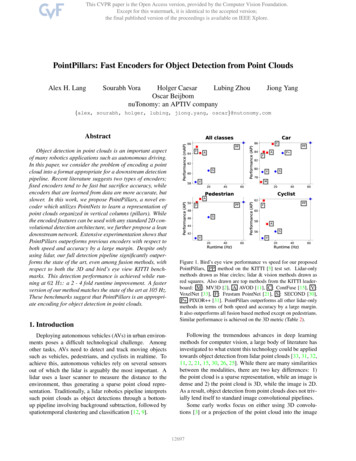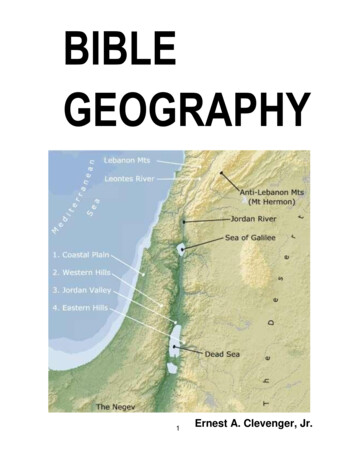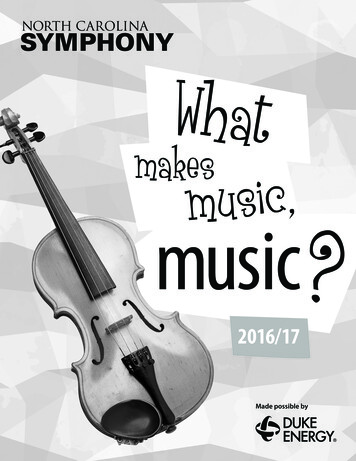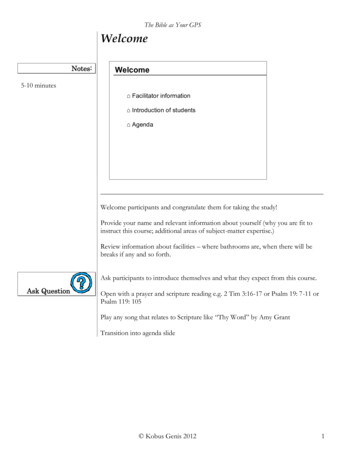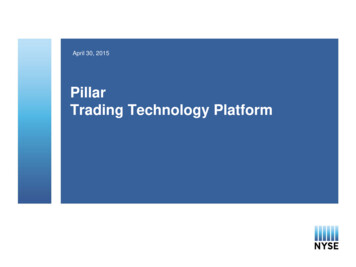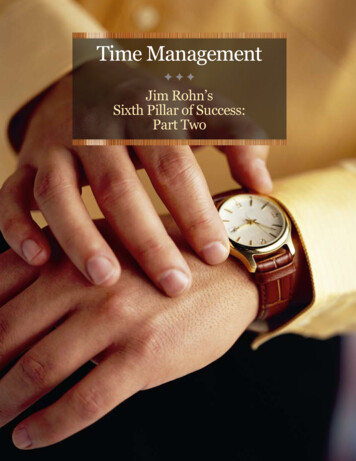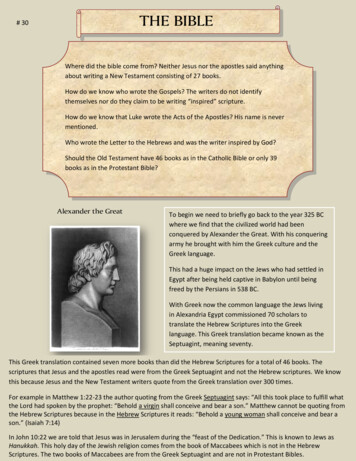
Transcription
THE BIBLE# 30Where did the bible come from? Neither Jesus nor the apostles said anythingabout writing a New Testament consisting of 27 books.How do we know who wrote the Gospels? The writers do not identifythemselves nor do they claim to be writing “inspired” scripture.How do we know that Luke wrote the Acts of the Apostles? His name is nevermentioned.Who wrote the Letter to the Hebrews and was the writer inspired by God?Should the Old Testament have 46 books as in the Catholic Bible or only 39books as in the Protestant Bible?Alexander the GreatTo begin we need to briefly go back to the year 325 BCwhere we find that the civilized world had beenconquered by Alexander the Great. With his conqueringarmy he brought with him the Greek culture and theGreek language.This had a huge impact on the Jews who had settled inEgypt after being held captive in Babylon until beingfreed by the Persians in 538 BC.With Greek now the common language the Jews livingin Alexandria Egypt commissioned 70 scholars totranslate the Hebrew Scriptures into the Greeklanguage. This Greek translation became known as theSeptuagint, meaning seventy.This Greek translation contained seven more books than did the Hebrew Scriptures for a total of 46 books. Thescriptures that Jesus and the apostles read were from the Greek Septuagint and not the Hebrew scriptures. We knowthis because Jesus and the New Testament writers quote from the Greek translation over 300 times.For example in Matthew 1:22-23 the author quoting from the Greek Septuagint says: “All this took place to fulfill whatthe Lord had spoken by the prophet: “Behold a virgin shall conceive and bear a son.” Matthew cannot be quoting fromthe Hebrew Scriptures because in the Hebrew Scriptures it reads: “Behold a young woman shall conceive and bear ason.” (Isaiah 7:14)In John 10:22 we are told that Jesus was in Jerusalem during the “feast of the Dedication.” This is known to Jews asHanukkah. This holy day of the Jewish religion comes from the book of Maccabees which is not in the HebrewScriptures. The two books of Maccabees are from the Greek Septuagint and are not in Protestant Bibles.
Jesus never told the apostles to writeanything about His teachings. He told themto “Go therefore and make disciples of allnations, baptizing them in the name of theFather and of the Son and of the Holy Spirit,teaching them to observe all that I havecommanded you.” Matthew 28:19-20As the decades passed Paul began to writeletters to the troubled churches admonishingthem and praising them.Soon the Gospels were written as well asother letters like the Acts of the Apostles.But other books were written as well. TheDidache, the Shepherd of Hermas, the Letterto the Hebrews, the Letters of Clement, theEpistle of Barnabas, Revelation of John, theLetter to the Laodiceans, first and secondJohn, first and second Peter, the Epistle ofJames and the Epistle of Jude.The Gnostic GospelsBy the end of the second century over 200books were claimed by some to be theinspired word of God. The Gospel of Thomas,the Gospel of Mary, the Gospel of Judas, theGospel of Philip, the Gospel of the Lord, theGospel of Truth, the Secret Book of John andmany others.What books should be included in the Canonof Scripture? What was inspired?By the year 330 there was no recognizedCanon of Scripture. In other words, the Biblewe have today did not exist 300 years afterChrist ascended into heaven.
Eusebius of Caesarea writing around the year 324 AD“At this point it may be appropriate to listthe New Testament writings alreadyreferred to. The holy quartet of theGospels which are followed by the Acts ofthe Apostles. After this we must reckonthe epistles of Paul; following which wemust pronounce genuine the epistle ofJohn, and likewise the epistle of Peter. .But of those which are disputed,nevertheless familiar to the majority,there is the epistle of James, as it is called;and that of Jude; and the second epistle ofPeter; and the second and third of John, sonamed, whether they belong to theevangelist or perhaps to some other of thesame name as he. Among the spuriouswritings there are to be placed also thebook of the Acts of Paul, and theShepherd, as it is called, and theApocalypse of Peter; and, in addition tothese, the epistle of Barnabas, and the Teachings of the Apostles, as it is called; and, moreover,as I said, the Apocalypse of John if it seems right. (This last, as I said, is rejected by some, butothers give it a place among the acknowledged writings.) And among these some havereckoned also the Gospel of the Hebrews, a work which is especially acceptable to suchHebrews as received the Christ. Now all these would be among the disputed writings; butnevertheless we have been compelled to make a catalogue of these also, distinguishing thosewritings which the tradition of the Church has deemed true and genuine .The heretics putforward in the name of the apostles, the Gospels of Peter and Thomas and Matthias, or even ofsome others besides these, or as containing Acts of Andrew and John and the other apostles”.Pope Damasus IEusebius History of the ChurchIn the year 382 the Council of Rome underthe authority of Pope Damasus I listed thebooks of the Bible that we have today. Thiswas ratified at the Council of Hippo in 393,the Council of Carthage in 397 and theCouncil of Carthage in 419.
Council of Rome 382 AD"Likewise it has been said: Now indeed we must treat of the divine Scriptures, what the universalCatholic Church accepts and what she ought to shun."The order of the Old Testament begins here: Genesis one book, Exodus one book, Leviticus onebook, Numbers one book, Deuteronomy one book, Joshua one book, Judges one book, Ruth onebook, Kings four books (, II Kings, I, II Samuel ) I and II Chronicles, Psalms one book, Solomon threebooks, Proverbs one book, Ecclesiastes one book, Canticle of Canticles one book [Song of Songs],likewise Wisdom one book, Ecclesiasticus (Sirach) one book.Likewise the order of the Prophets. Isaiah one book. Jeremiah one book, (includes Baruch) withGinoth, that is, with his lamentations, Ezechiel one book, Daniel one book, Hosea, Micah one book,Joel one book, Obadiah, Jonah, Nahum one book, Habakkuk, Zephaniah, Zechariah, Malachi onebook.Likewise the order of the histories: Job one book, Tobit, Esdras two books, Esther one book, Judithone book, Machabees two books.Likewise ,the order of the writings of the New and eternal Testament which the holy and CatholicChurch supports. Of the Gospels, according to Matthew, one book, according to Mark one book,according to Luke one book, according to John one book.The Epistles of Paul in number fourteen. To the Romans one, to the Corinthians two, to theEphesians one, to the Thessalonians two, to the Galatians one, to the Philippians one, to theColossians one, to Timothy two, to Titus one, to Philemon one, to the Hebrews one.Likewise the Apocalypse of John ( Revelation),one book. And the Acts of the Apostles one book.Likewise the canonical epistles in number seven. Of Peter the Apostle, two epistles, of James theApostle one epistle, of John the Apostle one epistle, of another John, the presbyter, two epistles, ofJude the Zealot, the Apostles one epistle”The seven books in red were removed from the Bible by Protestants in the 17th century.This is why Catholic Bibles have 46 Old Testament books and Protestant Bibles have 39Old Testament Books. All Bibles have 27 New Testament books.Small fragment from the fourth centuryThe original manuscripts were written on papyrus orvellum and they soon began to deteriorate. It wastherefore necessary for the Catholic Church to makehandwritten copies of the entire Bible. Catholic monkscontinued this process until the invention of theprinting press in 1440. The first book to be printed wasthe Catholic Guttenberg Bible.Protestant Objection: The Catholic Church added seven books to the Bible at the Council of Trent in 1550.Catholic Answer: The seven books have always been in the Old Testament Scriptures as part of the GreekSeptuagint that was used by Jesus and the apostles. The oldest Greek manuscripts in existence all includethese seven books. Protestants removed these seven books from the Bible in the 17th century.
Protestant Objection: Catholics chained up Bibles to keep the people from reading them.Catholic Answer: It is estimated that in today dollars it would have cost over 100,000 to producea single bible. They were chained to keep them from being stolen so that people could read them.Today, libraries do the same. They chain valuable books or encase them in glass.Protestant Objection: The Catholic Church kept the bible in Latin, an unknown language.Catholic Answer: The Church translated the bible from Greek to Latin around the year 400. Thiswas because Latin was the common language of the Roman Empire.Protestant Objection: Martin Luther was the first to translation the bible into a common language.Catholic Answer: The Catholic Church has always translated the Bible into common languages.The oldest manuscripts that exist today are in Greek, Latin, Aramaic, Coptic, Syriac, Slavic, Gothic,Armenian, German and others.Protestant Objection: The Catholic Church burned biblesCatholic Answer: Yes the Church burned bible translations by dissident Catholics that includedheretical commentaries that taught false doctrines. At this time in history there was no separationof Church and State and teaching heresy was considered to be “treason” by the State. During thissame time Protestant John Calvin burned copies of the Servetus Bible.Protestant Objection: I can tell just by reading what is inspired. I don’t need the Catholic ChurchCatholic Answer: To this day no one knows who wrote the Letter to the Hebrews. It doesn’t claimto be inspired. We only know from Tradition the authors of the Gospels and the Acts of theApostles. None of the books of the Bible claim to be inspired. It was the Catholic Church, guidedby the Holy Spirit that discerned what was inspired and what was not.In Colossians 4:16 Saint Paul says, “See also that you read the letter from Laodicea.” Why isn’t theLetter to the Laodiceans in the Bible? It is because the Catholic Church determined that the Letterin her possession was a forgery. By what authority could the Church declare that? By the authoritygiven to her by Christ to bind on earth what is bound in heaven.Protestant Objection: The Catholic Church forbids interpretation of the bible.Catholic Answer: The Church allows interpretation of bible passages as long as that interpretationdoesn’t conflict with Church teaching.Protestant Objection: Christians are guided by the Holy Spirit to correctly interpret scripture.Catholic Answer: If they Holy Spirit were guiding Christians to correctly interpret scripture therewouldn’t be over 30,000 Protestant denominations with different interpretations. Only oneChurch, the Catholic Church, has the authority to correctly interpret scripture since the CatholicChurch was founded by Christ.In Acts 8:26-35 Philip the Deacon came upon an Ethiopian who was reading the scriptures andasked him, “Do you understand what you are reading? And he said, “How can I, unless someoneguides me.” Philip, as an ordained Deacon, had the apostolic authority to correctly interpret thescriptures. Likewise the Catholic Church has the apostolic authority to interpret the scriptures.
Protestant Objection: Athanasius had the exact New Testament Canon that we have today.Catholic Answer: Athanasius was a Bishop of the Catholic Church. He did have a list that wasidentical to our New Testament. However this was in the year 367 which is more than 330 years afterChrist. Other Bishops in other parts of the world had different lists with different books. Also,ProteAthanasius included Baruch in his Old Testament Canon. Baruch is not in Protestant bibles.Protestant Objection: In Acts 17 Paul taught from the scriptures to the Berean Jews about JesusChrist and in Acts 17:11 scripture says they, “Received the word with all eagerness, examining thescriptures daily to see if these things were so.” That proves that all we need is the bible. We need tobe like the Bereans and search the scriptures.Catholic Answer: The Berean Jews were using scripture “alone” and it did not help them to recognizeJesus as their Messiah. It took Paul, a bishop of the Church, who had apostolic authority to interpretthe scriptures correctly for them. Just like the Ethopian they needed someone with apostolicauthority to guide them and find the true meaning of the passage.The bible actually forbids private interpretation. Peter warns us that even in his day destructiveheresies came about because of private interpretation:“First of all you must understand this, that no prophecy of scripture is a matter of one’s owninterpretation, because no prophecy ever came by the impulse of man, but men moved by the HolySpirit spoke for God. But false teachers also arose among the people, just as there will be falseteachers among you, who will secretly bring in destructive heresies, even denying the Master whobrought them, bringing upon themselves swift destruction.” 2 Peter 1:20-2:1Peter also said that untrained and un-established people can twist the words of scripture.“Paul also wrote to you according to the wisdom given him, speaking of this as he does in all hisletters. There are some things in them hard to understand, which the unlearned and unstable twistto their own destruction as they do they other scriptures.” 2 Peter 3:16The Queen James BibleWhen one rejects that Christ established an authoritativeChurch then there are no limits as to how far men will go topromote their own agendas. We now have the ultimateexample, the Queen James Bible where the editors plainlystate, "We edited the Bible to prevent homophobicinterpretations."Any verses that condemn homosexual sex have been retranslated to say that it was idolatry and not homosexual sexthat was condemned by God.An article on five myths about the seven books that are not in Protestant bibles: HERERecommended book: Where We Got the Bible by Henry GrahamNext topic: The Crusades and The Inquisition.
The Gnostic Gospels “At this point it may be appropriate to list the New Testament writings already referred to. The holy quartet of the Gospels which are followed by the Acts of . This is why Catholic Bibles have 46 Old Testament books and Protestant Bibles have 39 Old Testament Books.
